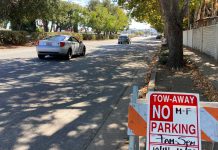While there’s a prolonged lull in development, the City of
Gilroy should be fashioning a new plan for the future, a plan that
matches a clear vision with realistic resources. The plan should be
based on the permanent economic reset which continues to unfold.
Unfortunately, it’s not happening and the leadership vacuum needs
to be filled.
Three recent, geographically scattered requests to include
another 600-plus acres and thousands more homes in the city’s urban
services boundary drove home the point: It’s business as usual.
Same old, same old … stack the deck with land, build, build,
build and they will come.
Gilroy’s been lucky rather than good in the planning department.
But our city has a chance to be good, to define its future during
this economic time-out in a way that hasn’t been done before.
Where, exactly, should our city’s boundaries be? What’s the ratio
of park acreage to population? What about traffic service levels?
How and where are we going to build schools?
Our suggestion to get the ball rolling
– a reverse retreat where an active and involved panel of
residents talks to the City Council. Ultimately, that is where the
political will must come from if Gilroy is to avoid haphazard,
case-by-case planning decisions that have introduced the mish and
the mash into our landscape. And it is the C
ity Council that, after listening intently, must make the tough
choices.
Included, too, in the vision for Gilroy’s future must be a
resource plan. How much gets spent on what? And that has to be
fashioned with understanding. If the city spends 75 percent of the
General Fund budget on public safety, is the ability to maintain
parks diminished to unacceptable levels? Is there a proper
percentage to spend on recreation? If contracting for fire and/or
police services could save $4 million each year or more, should
Gilroy ask alternate agencies for Requests for Proposals in order
to compare and contrast? What the Council needs is serious feedback
on putting together the budget
”
pie.
”
An informed panel, devoid of political agendas, could provide a
general direction.
City Administrator Tom Haglund, articulate and organized, is an
obvious choice to take the post-retreat reins, provide objective
analysis of options and fashion a thoughtful agenda based on the
guidelines provided by the Council.
If it doesn’t happen now, Gilroy will have missed an opportunity
to cast a clear outline for the future
– a blueprint that residents, elected officials and city
employees understand. Missing that chance would be a serious
misstep.
While there’s a prolonged lull in development, the City of Gilroy should be fashioning a new plan for the future, a plan that matches a clear vision with realistic resources. The plan should be based on the permanent economic reset which continues to unfold. Unfortunately, it’s not happening and the leadership vacuum needs to be filled.
Three recent, geographically scattered requests to include another 600-plus acres and thousands more homes in the city’s urban services boundary drove home the point: It’s business as usual. Same old, same old … stack the deck with land, build, build, build and they will come.
Gilroy’s been lucky rather than good in the planning department. But our city has a chance to be good, to define its future during this economic time-out in a way that hasn’t been done before. Where, exactly, should our city’s boundaries be? What’s the ratio of park acreage to population? What about traffic service levels? How and where are we going to build schools?
Our suggestion to get the ball rolling – a reverse retreat where an active and involved panel of residents talks to the City Council. Ultimately, that is where the political will must come from if Gilroy is to avoid haphazard, case-by-case planning decisions that have introduced the mish and the mash into our landscape. And it is the City Council that, after listening intently, must make the tough choices.
Included, too, in the vision for Gilroy’s future must be a resource plan. How much gets spent on what? And that has to be fashioned with understanding. If the city spends 75 percent of the General Fund budget on public safety, is the ability to maintain parks diminished to unacceptable levels? Is there a proper percentage to spend on recreation? If contracting for fire and/or police services could save $4 million each year or more, should Gilroy ask alternate agencies for Requests for Proposals in order to compare and contrast? What the Council needs is serious feedback on putting together the budget “pie.” An informed panel, devoid of political agendas, could provide a general direction.
City Administrator Tom Haglund, articulate and organized, is an obvious choice to take the post-retreat reins, provide objective analysis of options and fashion a thoughtful agenda based on the guidelines provided by the Council.
If it doesn’t happen now, Gilroy will have missed an opportunity to cast a clear outline for the future – a blueprint that residents, elected officials and city employees understand. Missing that chance would be a serious misstep.











